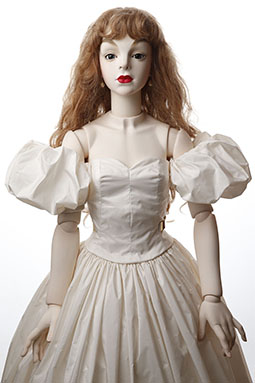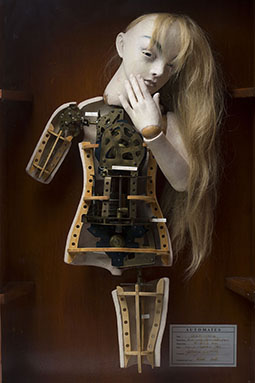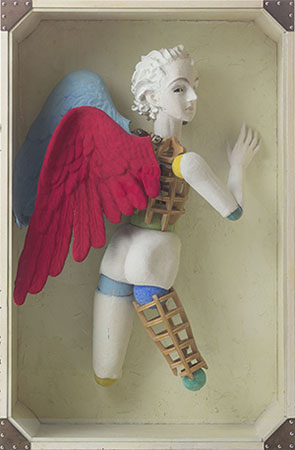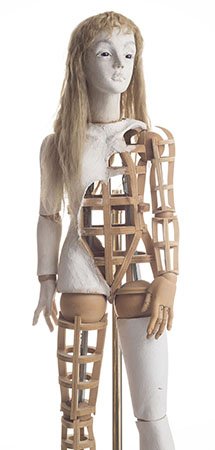 |
Focus features two in-depth reviews each month of fine art, architecture and design exhibitions and events at art museums, galleries and alternative spaces around Japan. The contributors are non-Japanese art critics living in Japan. |
|
|
 |
 |
 |
All Dolled Up: The Simon Yotsuya Exhibition
Christopher Stephens |
 |
|
 |
|
|
|
Velvet Boy 1 (1985),
Private Collection
|
Despite being such a ubiquitous cultural artifact for much of world history, dolls were curiously absent from art of the 20th century, with the notable exception of the German surrealist Hans Bellmer (1902-75). Inspired by Offenbach's opera The Tales of Hoffman, which centers on the title character's love for an automaton named Olympia, Bellmer created his first doll in the early 1930s. This led to a series of increasingly subversive depictions of the female form that included articulated joints, round stomachs, and abbreviated ball-shaped limbs. Ultimately, Bellmer replaced the head and torso of his dolls with a set of legless hips pointing upward to create an enigmatic blend of geometric construct and erotic desire.
By the time he had graduated from middle school, Tokyo native Simon Yotsuya, who turned 70 this year, was already determined to dedicate his life to doll-making. It wasn't until 1965, however, when he saw photographs of Bellmer's work in a magazine, that he found his way as an artist. The recent Simon Doll exhibition at the Otani Memorial Art Museum in Nishinomiya City, held from October 11 to November 30, 2014, presented an overview of Yotsuya's career through a collection of 46 works thematically divided into six sections: "Innocent Things: Young Boys and Girls," "Tempting Things: Women," "Automatic Things: Mechanical Devices," "Heavenly Things: Angels and Christ," "Creations of the Self: Simon," and "Unfinished Things and Homage to Bellmer."
In the early '60s, while working at a jazz coffee shop in Shinjuku, Yotsuya developed a passion for the work of the American singer Nina Simone, earning him the nickname "Simon" (pronounced “Simone”). Though his devotion to doll-making never waned, for several years in the late '60s and early '70s Yotsuya pursued a parallel career as an actor. As a member of Juro Kara's legendary underground theater company Jokyo Gekijo (Situation Theatre), he regularly portrayed a female doll until leaving the stage in 1971 to concentrate on his own work.
 |
|
 |
|
|
|
Portrait de Petite Fille (2008),
Kamada Kyosai Non-Profit Foundation Collection |
|
Mechanical Girl 1 (1979/83), Naruse Art Center Collection |
Yotsuya's output of the '80s includes a number of refined-looking boys and girls in fancy dress. Velvet Boy 1 (1985), for example, depicts a sandy-haired boy in a velvet jacket and short pants, a bow tie, and Oxford-style boots. In contrast to his dandyish appearance, his features are somewhat forlorn, with droopy eyes and a downturned mouth. The boy's female counterparts are clad in similarly stunning red and white dresses and flowing blonde locks. This series is a technical marvel but almost too perfect to make much of an impression.
On the other hand, the mechanical dolls that Yotsuya began making in 1979 offer more insight into his production process, and in their half-finished state, they are also more eye-catching. Mechanical Girl 1, the first work of this type, portrays a girl with strong arching eyebrows and a tilted head. Her left hand brushes coyly against her cheek as she peers out with a dreamy gaze from behind a long shock of blonde hair. This is the extent of her finished qualities. The rest of her body is a work in progress, with a left leg that doesn't quite reach the knee, a right arm that ends before the elbow, and no right leg at all. More importantly, her limbs and chest are open, revealing the wooden frames that define her shape and the complex network of metal gears, axles, and shafts that make her run.
 |
|
 |
|
|
|
Anges Mélangés, Anges Dérangés a l’áme de M. Shibusawa (1990), Private Collection |
|
Wood-Framed Girl (1981/83), Private Collection
All works by Simon Yotsuya; images courtesy of the Otani Memorial Art Museum, Nishinomiya City. |
Yotsuya seems to have had an uncanny ability to befriend the most important cultural figures of his era -- fashion designer Junko Koshino, butoh dancer Tatsumi Hijikata, and painter Kuniyoshi Kaneko among them. But no one proved to be quite as important to him as Tatsuhiko Shibusawa. Translator of the Marquis de Sade and author of countless books on esoteric aspects of European art and culture, Shibusawa had written the article on Bellmer that caused Yotsuya to discard all of his early works and incorporate ball joints into his dolls. The two later enjoyed a close friendship that lasted until Shibusawa's death in 1987. Devastated by this loss, Yotsuya found it impossible to work for nearly two years. He eventually found solace in the Eastern Orthodox Church and was inspired to make a series of angels, which he dedicated to Shibusawa, and straightforward images of Christ.
In recent years, Yotsuya has moved away from perfection. Instead, he emphasizes the unique qualities of his materials by leaving the plaster in an unfinished state and applying paint in a patchy manner. This is in part a homage to Bellmer. It also imbues the work with a poignancy that was sometimes missing from his earlier efforts. The dolls themselves are still young and alluring, but their physical deterioration gives us the sense that, like us, they are not immune to the power of time.
 |
 |
Christopher Stephens
Christopher Stephens has lived in the Kansai region for over 25 years. In addition to appearing in numerous catalogues for museums and art events throughout Japan, his translations on art and architecture have accompanied exhibitions in Spain, Germany, Switzerland, Italy, Belgium, South Korea, and the U.S. His recent published work includes From Postwar to Postmodern: Art in Japan 1945-1989: Primary Documents (MoMA Primary Documents, 2012) and Gutai: Splendid Playground (Solomon R. Guggenheim Museum, 2013). |
|
 |
|